Variation in Plasma Levels of Apixaban and Rivaroxaban in Clinical Routine Treatment of Venous Thromboembolism
Abstract
:1. Introduction
2. Materials and Methods
2.1. Identification and Inclusion of Patients
2.2. Measurement of Plasma Levels of DOACs and D-dimer
2.3. Statistical Analysis
3. Results
3.1. Study Population and Visits
3.2. DOAC Levels in the Study Population
3.3. Dependence of DOAC Levels on Patient Characteristics
3.4. DOAC Levels Show Good Intra-Individual Agreement in Repeated Measurements
3.5. Follow-Up of Patients Who Switched Anticoagulants
4. Discussion
5. Conclusions
Author Contributions
Funding
Institutional Review Board Statement
Informed Consent Statement
Data Availability Statement
Conflicts of Interest
References
- Reitsma, P.H.; Versteeg, H.H.; Middeldorp, S. Mechanistic view of risk factors for venous thromboembolism. Arterioscler. Thromb. Vasc. Biol. 2012, 32, 563–568. [Google Scholar] [CrossRef] [PubMed] [Green Version]
- Naess, I.A.; Christiansen, S.C.; Romundstad, P.; Cannegieter, S.C.; Rosendaal, F.R.; Hammerstrøm, J. Incidence and mortality of venous thrombosis: A population-based study. J. Thromb. Haemost. 2007, 5, 692–699. [Google Scholar] [CrossRef] [PubMed]
- Oger, E. Incidence of venous thromboembolism: A community-based study in Western France. EPI-GETBP Study Group. Groupe d’Etude de la Thrombose de Bretagne Occidentale. Thromb. Haemost. 2000, 83, 657–660. [Google Scholar] [PubMed]
- Barnes, G.D.; Lucas, E.; Alexander, G.C.; Goldberger, Z.D. National trends in ambulatory oral anticoagulant use. Am. J. Med. 2015, 128, 1300–1305. [Google Scholar] [CrossRef] [Green Version]
- Van Es, N.; Coppens, M.; Schulman, S.; Middeldorp, S.; Buller, H.R. Direct oral anticoagulants compared with vitamin K antagonists for acute venous thromboembolism: Evidence from phase 3 trials. Blood 2014, 124, 1968–1975. [Google Scholar] [CrossRef]
- Kearon, C.; Akl, E.A.; Ornelas, J.; Blaivas, A.; Jimenez, D.; Bounameaux, H.; Huisman, M.; King, C.S.; Morris, T.A.; Sood, N.; et al. Antithrombotic Therapy for VTE Disease: CHEST Guideline and Expert Panel Report. Chest 2016, 149, 315–352. [Google Scholar] [CrossRef]
- Dale, B.J.; Chan, N.C.; Eikelboom, J.W. Laboratory measurement of the direct oral anticoagulants. Br. J. Haematol. 2016, 172, 315–336. [Google Scholar] [CrossRef] [Green Version]
- Perzborn, E.; Strassburger, J.; Wilmen, A.; Pohlmann, J.; Roehrig, S.; Schlemmer, K.H.; Straub, A. In vitro and in vivo studies of the novel antithrombotic agent BAY 59-7939--an oral, direct Factor Xa inhibitor. J. Thromb. Haemost. 2005, 3, 514–521. [Google Scholar] [CrossRef]
- European Medicines Agency. Eliquis–Summary of Product Characteristics. Available online: http://www.ema.europa.eu/en/documents/product-information/eliquis-epar-product-information_en.pdf (accessed on 3 April 2022).
- European Medicines Agency. Xarelto–Summary of Product Characteristics. Available online: http://www.ema.europa.eu/en/documents/product-information/xarelto-epar-product-information_en.pdf (accessed on 3 April 2022).
- Mueck, W.; Lensing, A.W.; Agnelli, G.; Decousus, H.; Prandoni, P.; Misselwitz, F. Rivaroxaban: Population pharmacokinetic analyses in patients treated for acute deep-vein thrombosis and exposure simulations in patients with atrial fibrillation treated for stroke prevention. Clin. Pharmacokinet. 2011, 50, 675–686. [Google Scholar] [CrossRef]
- Mueck, W.; Borris, L.C.; Dahl, O.E.; Haas, S.; Huisman, M.V.; Kakkar, A.K.; Kälebo, P.; Muelhofer, E.; Misselwitz, F.; Eriksson, B.I. Population pharmacokinetics and pharmacodynamics of once- and twice-daily rivaroxaban for the prevention of venous thromboembolism in patients undergoing total hip replacement. Thromb. Haemost. 2008, 100, 453–461. [Google Scholar]
- Douxfils, J.; Gosselin, R.C. Laboratory assessment of direct oral anticoagulants (DOACs). Semin. Thromb. Haemost. 2017, 43, 277–290. [Google Scholar]
- Douxfils, J.; Adcock, D.M.; Bates, S.M.; Favaloro, E.J.; Gouin-Thibault, I.; Guillermo, C.; Kawai, Y.; Lindhoff-Last, E.; Kitchen, S.; Gosselin, R.C. 2021 Update of the International Council for Standardization in Haematology Recommendations for Laboratory Measurement of Direct Oral Anticoagulants. Thromb. Haemost. 2021, 121, 1008–1020. [Google Scholar] [CrossRef]
- Gosselin, R.C.; Adcock, D.M.; Bates, S.M.; Douxfils, J.; Favaloro, E.J.; Gouin-Thibault, I.; Guillermo, C.; Kawai, Y.; Lindhoff-Last, E.; Kitchen, S. International Council for Standardization in Haematology (ICSH) Recommendations for Laboratroy Measurement of Direct Oral Anticoagulants. Thromb. Haemost. 2018, 118, 437–450. [Google Scholar]
- Patel, J.P.; Byrne, R.A.; Patel, R.K.; Arya, R. Progress in the monitoring of direct oral anticoagulant therapy. Br. J. Haematol. 2019, 184, 912–924. [Google Scholar] [CrossRef]
- Rohde, G. Determination of rivaroxaban-a novel, oral, direct Factor Xa inhibitor-in human plasma by high-performance liquid chromatography-tandem mass spectrometry. J. Chromatogr. B Analyt. Technol. Biomed Life Sci. 2008, 872, 43–50. [Google Scholar] [CrossRef]
- Kubitza, D.; Becka, M.; Wensing, G.; Voith, B.; Zuehlsdorf, M. Safety, pharmacodynamics, and pharmacokinetics of BAY 59-7939-an oral, direct Factor Xa inhibitor-after multiple dosing in healthy male subjects. Eur. J. Clin. Pharmacol. 2005, 61, 873–880. [Google Scholar] [CrossRef]
- Barrett, Y.C.; Wang, J.; Song, Y.; Pursley, J.; Wastall, P.; Wright, R.; Lacreta, F.; Frost, C. A randomised assessment of the pharmacokinetic, pharmacodynamic and safety interaction between apixaban and enoxaparin in healthy subjects. Thromb. Haemost. 2012, 107, 916–924. [Google Scholar]
- Gouin-Thobault, I.; Flaujac, C.; Delavenne, X.; Quenet, S.; Horellou, M.H.; Laporte, S.; Siguret, V.; Lecompte, T. Assessment of apixaban plasma levels by laboratory tests: Suitability of three anti-Xa assays. A multicentre French GEHT study. Thromb. Haemost. 2014, 11, 240–248. [Google Scholar]
- Schmitz, E.M.; Boonen, K.; van den Heuvel, D.J.; van Dongen, J.L.; Schellings, M.W.; Emmen, J.M.; van der Graaf, F.; Brunsveld, L.; van de Kerkhof, D. Determination of dabigatran, rivaroxaban and apixaban by ultra-performance liquid chromatography-tandem mass spectrometry (UPLC-MS/MS) and coagulation assays for therapy monitoring of novel direct oral anticoagulants. J. Thromb. Haemost. 2014, 12, 1636–1646. [Google Scholar] [CrossRef]
- Douxfils, J.; Tamigniau, A.; Chatelain, B.; Chatelain, C.; Wallemacq, P.; Dogné, J.M.; Mullier, F. Comparison of calibrated chromogenic anti-Xa assay and PT tests with LC-MS/MS for the therapeutic monitoring of patients treated with rivaroxaban. Thromb. Haemost. 2013, 110, 723–731. [Google Scholar]
- Testa, S.; Tripodi, A.; Legnani, C.; Pengo, V.; Abbate, R.; Dellanoce, C.; Carraro, P.; Salomone, L.; Paniccia, R.; Paoletti, O.; et al. START-Laboratory Register. Plasma levels of direct oral anticoagulants in real life patients with atrial fibrillation: Results observed in four anticoagulation clinics. Thromb. Res. 2016, 137, 178–183. [Google Scholar] [CrossRef] [Green Version]
- Gulilat, M.; Tang, A.; Gryn, S.E.; Leong-Sit, P.; Skanes, A.C.; Alfonsi, J.E.; Dresser, G.K.; Henderson, S.L.; Rose, R.V.; Lizotte, D.J.; et al. Interpatient Variation in Rivaroxaban and Apixaban Plasma Concentrations in Routine Care. Can. J. Cardiol. 2017, 33, 1036–1043. [Google Scholar] [CrossRef]
- Miklič, M.; Mavri, A.; Vene, N.; Söderblom, L.; Božič-Mijovski, M.; Pohanka, A.; Antovic, J.; Malmström, R.E. Intra- and inter- individual rivaroxaban concentrations and potential bleeding risk in patients with atrial fibrillation. Eur. J. Clin. Pharmacol. 2019, 75, 1069–1075. [Google Scholar] [CrossRef]
- Mavri, A.; Vene, N.; Božič-Mijovski, M.; Miklič, M.; Söderblom, L.; Pohanka, A.; Malmström, R.E.; Antovic, J. Apixaban concentration variability and relation to clinical outcomes in real-life patients with atrial fibrillation. Sci. Rep. 2021, 11, 13908. [Google Scholar] [CrossRef]
- Wright, C.; Brown, R.; Cuker, A. Laboratory measurement of the direct oral anticoagulants: Indications and impact on management in clinical practice. Int. J. Lab. Hematol. 2017, 39 (Suppl. 1), 31–36. [Google Scholar] [CrossRef] [Green Version]
- Bavalia, R.; Veenhuizen, J.E.; Hengeveld, R.C.C.; Braeken, D.; Gulpen, A.J.W.; ten Cate, H.; Middeldorp, S.; Henskens, Y.M.C.; Hutten, B.A.; Coppens, M.; et al. Direct oral anticoagulant blood level monitoring in daily practice. Thromb. Update 2021, 3, 100049. [Google Scholar] [CrossRef]
- Rottenstreich, A.; Zacks, N.; Kleinstern, G.; Raccah, B.H.; Roth, B.; Da’as, N.; Kalish, Y. Direct-acting oral anticoagulant drug level monitoring in clinical patient management. J. Thromb. Thrombolysis 2018, 45, 543–549. [Google Scholar] [CrossRef] [PubMed]
- Doherty, J.U.; Gluckman, T.J.; Hucker, W.J.; Januzzi, J.L., Jr.; Ortel, T.L.; Saxonhouse, S.J.; Spinler, S.A. 2017 ACC Expert Consensus Decision Pathway for Periprocedural Management of Anticoagulation in Patients with Nonvalvular Atrial Fibrillation: A Report of the American College of Cardiology Clinical Expert Consensus Document Task Force. J. Am. Coll. Cardiol. 2017, 69, 871–898. [Google Scholar] [CrossRef] [PubMed]
- Spyropoulos, A.C.; Brohi, K.; Caprini, J.; Samama, C.M.; Siegal, D.; Tafur, A.; Verhamme, P.; Douketis, J.D.; SSC Subcommittee on Perioperative and Critical Care Thrombosis and Haemostasis of the International Society on Thrombosis and Haemostasis. Scientific and Standardization Committee Communication: Guidance document on the periprocedural management of patients on chronic oral anticoagulant therapy: Recommendations for standardized reporting of procedural/surgical bleed risk and patient-specific thromboembolic risk. J. Thromb. Haemost. 2019, 17, 1966–1972. [Google Scholar] [PubMed] [Green Version]
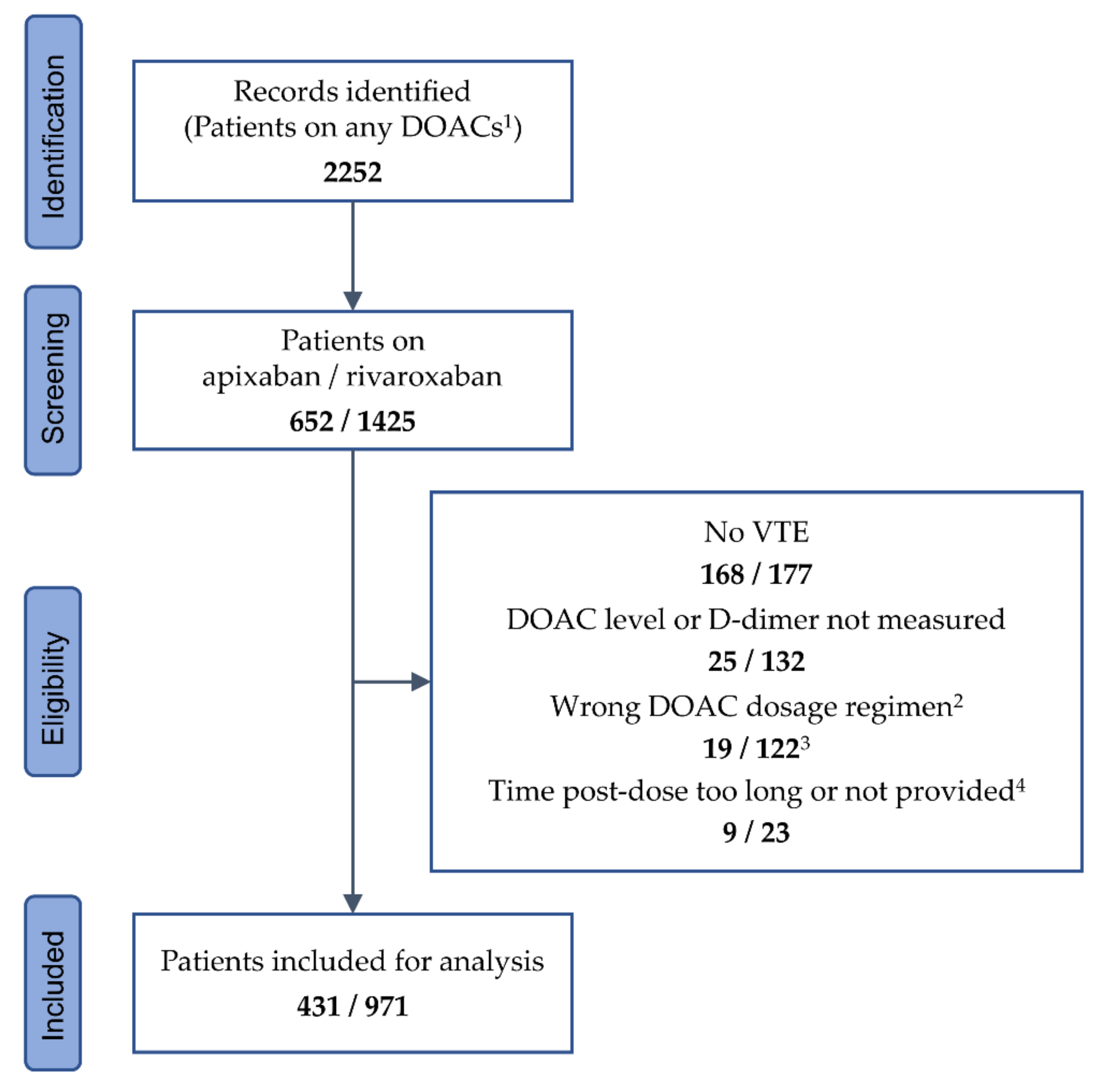
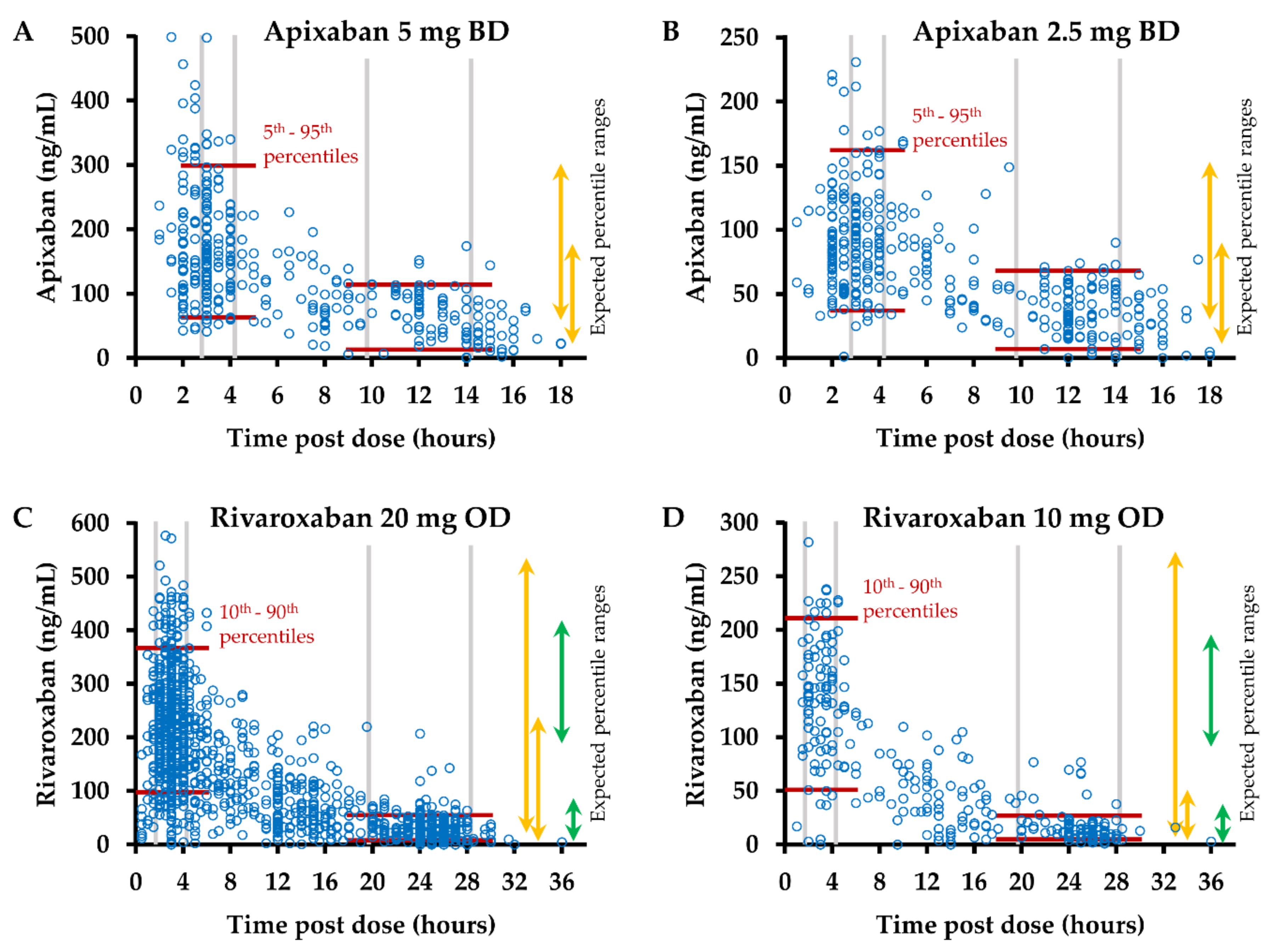
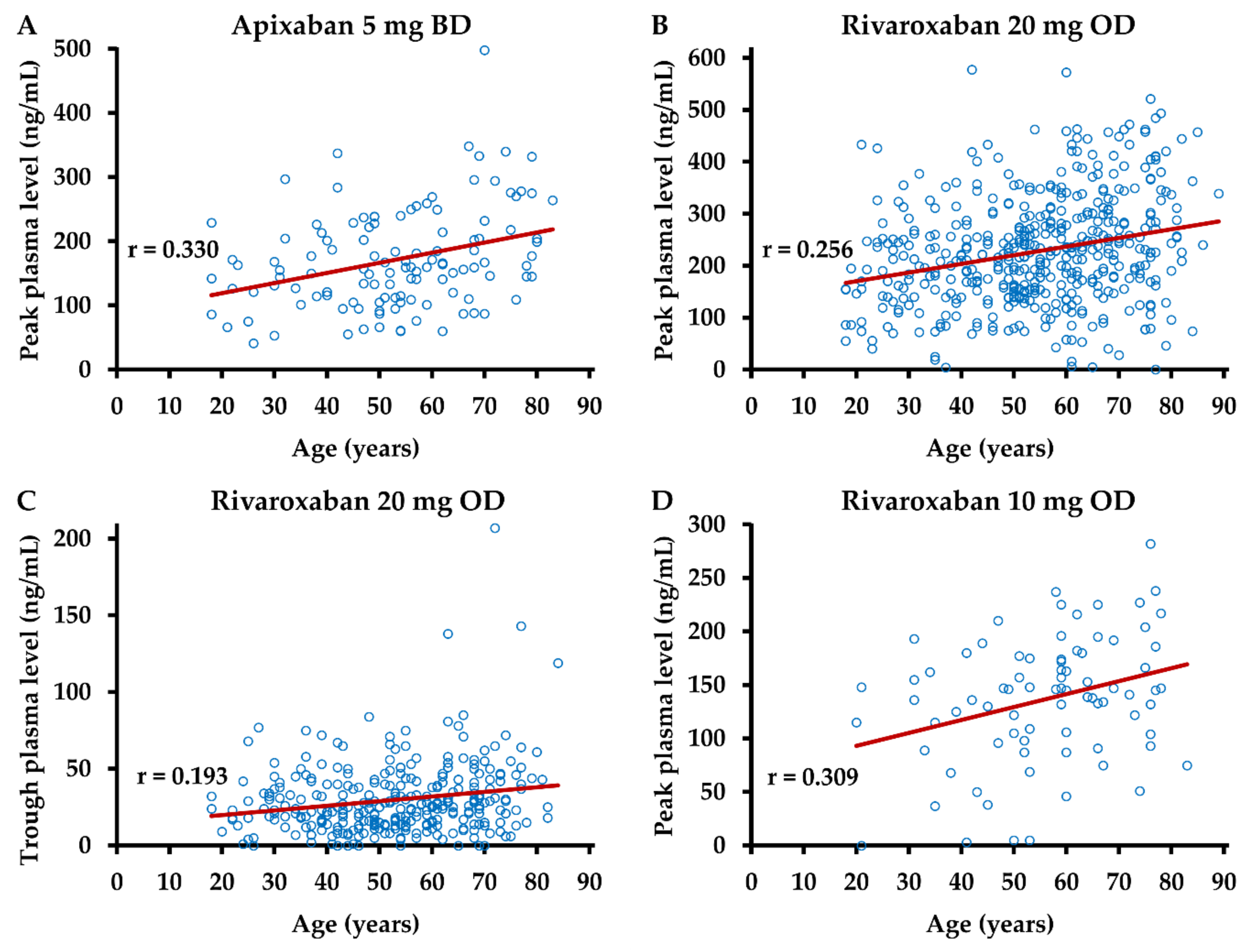
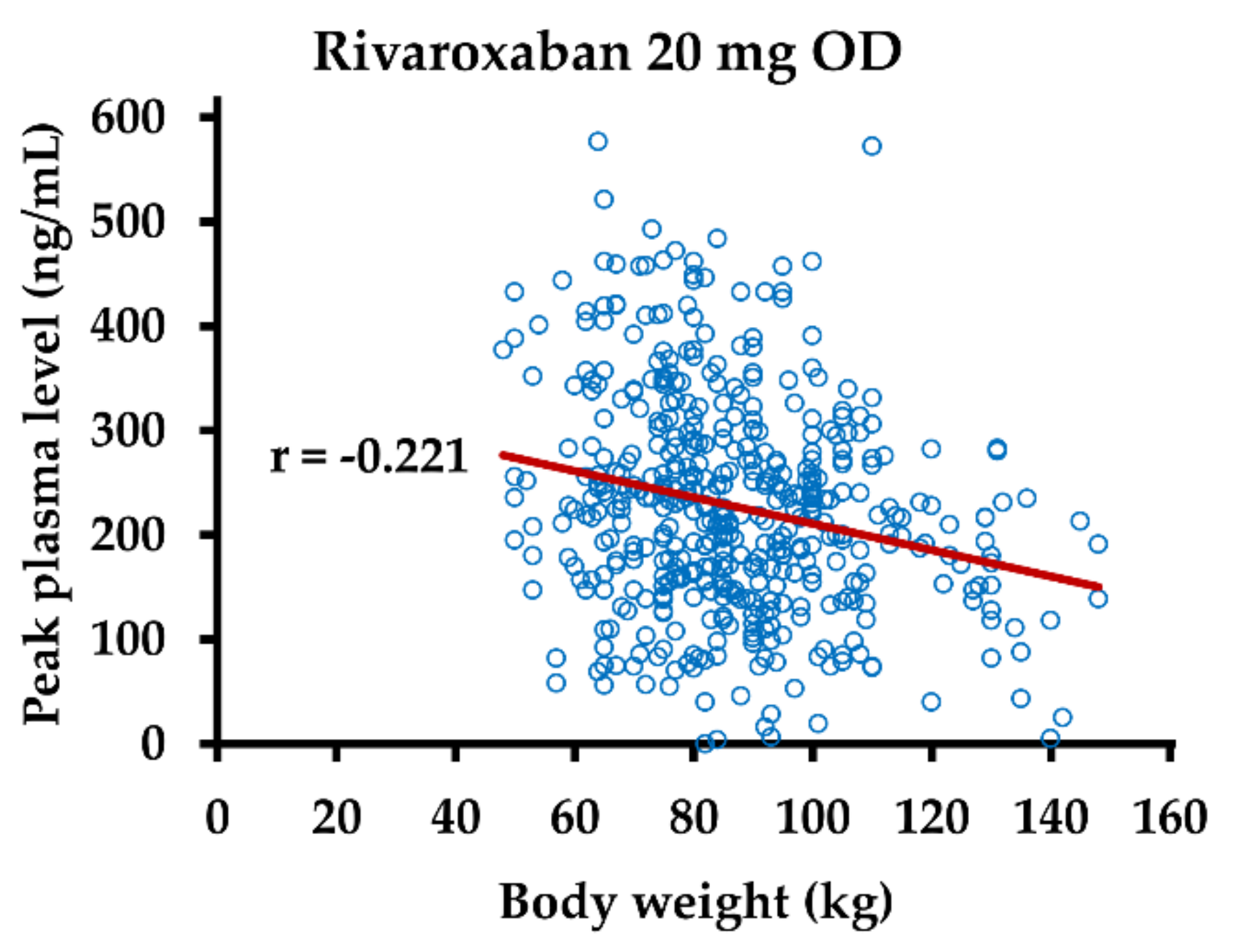
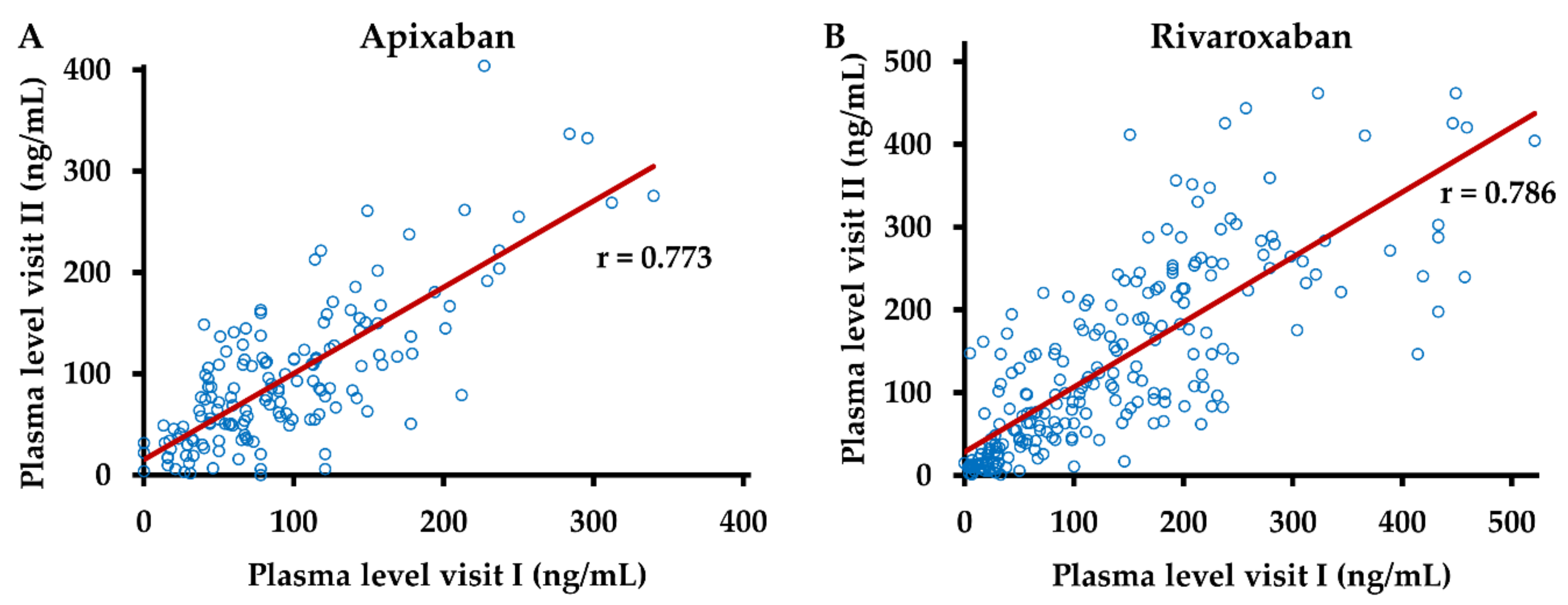
| Drug and Dosage | Interval Post Dose (Hours) | Drug Level *, ng/mL | Reference |
|---|---|---|---|
| Apixaban 5 mg BD | Peak (3–4) | 132 (59–302) | SmPC [9] |
| Trough (about 12) | 63 (22–177) | SmPC [9] | |
| Apixaban 2.5 mg BD | Peak (3–4) | 67 (30–153) | SmPC [9] |
| Trough (about 12) | 32 (11–90) | SmPC [9] | |
| Rivaroxaban 20 mg OD | Peak (2–4) | 270 (189–419) | Mueck et al. [11] |
| Trough (20–28) | 26 (6–87) | Mueck et al. [11] | |
| Peak (2–4) | 215 (22–535) | SmPC [10] | |
| Trough (about 24) | 32 (6–239) | SmPC [10] | |
| Rivaroxaban 10 mg OD | Peak (2–4) | 125 (91–196) | Mueck et al. [12] |
| Trough (20–28) | 9 (1–38) | Mueck et al. [12] | |
| Peak (2–4) | 101 (7–273) | SmPC [10] | |
| Trough (about 24) | 14 (4–51) | SmPC [10] |
| Drug | Apixaban | Rivaroxaban | p 1 |
|---|---|---|---|
| Patients, n | 431 | 971 | - |
| Sex, male/female, n | 169/262 | 482/489 | 4 × 10−4 |
| Age, years (median, IQR) 2 | 55 (42–67) | 53 (41–64) | ns |
| Body weight, kg (median, IQR) 2 | 83 (70–95) | 83 (73–96) | ns |
| BMI, kg/m2 (median, IQR) 2 | 27.1 (24.3–30.8) | 27.3 (24.4–30.8) | ns |
| D-dimer level, mg/L (median, IQR) 2 | 0.34 (0.22–0.53) | 0.27 (0.19–0.42) | 1.3 × 10−7 |
| Patients with the first event of VTE, n (%) | 283 (66%) | 651 (67%) | ns |
| Thereof DVT, n (%) | 121 (28%) | 304 (31%) | ns |
| DVT with pulmonary embolism, n (%) | 75 (17%) | 197 (20%) | ns |
| Isolated pulmonary embolism, n (%) | 87 (20%) | 150 (15%) | 0.034 |
| Patients with recurrent VTE, n (%) | 148 (34%) | 320 (33%) | ns |
| Patients with one visit completed, n (%) | 237 (55%) | 626 (64%) | <10−4 |
| Two visits completed, n (%) | 121 (28%) | 230 (24%) | ns |
| Three visits completed, n (%) | 46 (11%) | 75 (8%) | ns |
| Four visits completed, n (%) | 27 (6%) | 40 (4%) | ns |
| Visits included in the analysis, n | 725 | 1471 | - |
| Thereof on apixaban 5/2.5 mg twice daily, n (%) | 360 (50%)/365 (50%) | - | - |
| Rivaroxaban 20/10 mg once daily, n (%) | - | 1180 (80%)/291 (20%) | - |
| Drug | Apixaban | Rivaroxaban | |||
|---|---|---|---|---|---|
| 5 mg BD | 2.5 mg BD | 20 mg OD | 10 mg OD | ||
| Peak | Interval post dose, hours | 3–4 | 3–4 | 2–4 | 2–4 |
| Samples, n | 120 | 92 | 476 | 80 | |
| Drug level, ng/Ml 1 | 160 (63–299) | 90 (37–161) | 227 (98–367) | 137 (51–211) | |
| Mean ± SD, ng/mL (CV) | 171 ± 78 (45%) | 94 ± 41 (43%) | 227 ± 104 (46%) | 137 ± 59 (43%) | |
| Not in range [9,10], n (%) | 9 (7.5%) | 12 (13.0%) | 24 (5.0%) | 5 (6.4%) | |
| Not in range [11,12], n (%) | - | - | 207 (43.5%) | 26 (32.5%) | |
| ≤50 ng/mL, n (%) | 1 (0.8%) | 14 (15.2%) | 12 (2.5%) | 8 (10.0%) | |
| ≤30 ng/mL, n (%) | 0 | 3 (3.3%) | 8 (1.7%) | 4 (5.0%) | |
| Trough | Interval post dose, hours | 10–14 | 10–14 | 20–28 | 20–28 |
| Samples, n | 72 | 101 | 312 | 104 | |
| Drug level, ng/mL 1 | 71 (13–114) | 34 (7–68) | 30 (8–55) | 16 (5–27) | |
| Mean ± SD, ng/mL (CV) | 70 ± 38 (53%) | 37 ± 20 (46%) | 30 ± 23 (78%) | 16 ± 15 (95%) | |
| Not in range [9,10], n (%) | 5 (6.9%) | 7 (6.9%) | 20 (6.4%) | 12 (11.5%) | |
| Not in range [11,12], n (%) | - | - | 24 (7.7%) | 8 (7.7%) | |
| >50 ng/mL, n (%) | 45 (63%) | 32 (32%) | 43 (13.8%) | 5 (4.8%) | |
| >30 ng/mL, n (%) | 60 (83%) | 61 (60%) | 189 (60.6%) | 9 (8.7%) | |
Publisher’s Note: MDPI stays neutral with regard to jurisdictional claims in published maps and institutional affiliations. |
© 2022 by the authors. Licensee MDPI, Basel, Switzerland. This article is an open access article distributed under the terms and conditions of the Creative Commons Attribution (CC BY) license (https://creativecommons.org/licenses/by/4.0/).
Share and Cite
Reda, S.; Rudde, E.; Müller, J.; Hamedani, N.S.; Oldenburg, J.; Pötzsch, B.; Rühl, H. Variation in Plasma Levels of Apixaban and Rivaroxaban in Clinical Routine Treatment of Venous Thromboembolism. Life 2022, 12, 705. https://doi.org/10.3390/life12050705
Reda S, Rudde E, Müller J, Hamedani NS, Oldenburg J, Pötzsch B, Rühl H. Variation in Plasma Levels of Apixaban and Rivaroxaban in Clinical Routine Treatment of Venous Thromboembolism. Life. 2022; 12(5):705. https://doi.org/10.3390/life12050705
Chicago/Turabian StyleReda, Sara, Eva Rudde, Jens Müller, Nasim Shahidi Hamedani, Johannes Oldenburg, Bernd Pötzsch, and Heiko Rühl. 2022. "Variation in Plasma Levels of Apixaban and Rivaroxaban in Clinical Routine Treatment of Venous Thromboembolism" Life 12, no. 5: 705. https://doi.org/10.3390/life12050705
APA StyleReda, S., Rudde, E., Müller, J., Hamedani, N. S., Oldenburg, J., Pötzsch, B., & Rühl, H. (2022). Variation in Plasma Levels of Apixaban and Rivaroxaban in Clinical Routine Treatment of Venous Thromboembolism. Life, 12(5), 705. https://doi.org/10.3390/life12050705








